Optimal Positioning of RTC Actuators and SuDS for Sewer Overflow Mitigation in Urban Drainage Systems
Abstract
:1. Introduction
2. Methodology
2.1. Case Studies
2.2. SuDS Zones
2.3. Flow Control Devices
2.4. Selection of Optimal SuDS and FCD Locations
2.4.1. Genetic Algorithm
2.4.2. FCD Locations Evaluated by GA
2.5. Rainfall Events
3. Results
3.1. Arendonk Catchment
3.2. Zona Central Catchment
3.3. Validation with Continuous Rainfall Series
4. Discussion
5. Conclusions
Author Contributions
Funding
Data Availability Statement
Acknowledgments
Conflicts of Interest
References
- Hosseinzadehtalaei, P.; Tabari, H.; Willems, P. Climate change impact on short-duration extreme precipitation and intensity–duration–frequency curves over Europe. J. Hydrol. 2020, 590, 125249. [Google Scholar] [CrossRef]
- Zhou, Q.; Leng, G.; Su, J.; Ren, Y. Comparison of urbanization and climate change impacts on urban flood volumes: Importance of urban planning and drainage adaptation. Sci. Total Environ. 2019, 658, 24–33. [Google Scholar] [CrossRef] [PubMed]
- Zittis, G.; Bruggeman, A.; Lelieveld, J. Revisiting future extreme precipitation trends in the Mediterranean. Weather Clim. Extrem. 2021, 34, 100380. [Google Scholar] [CrossRef] [PubMed]
- CEC. Council Directive of 21 May 1991 concerning urban waste water treatment (91/271/EEC). Off. J. Eur. Communities 1991. [Google Scholar]
- Environment Agency. Storm Overflow Assessment Framework. 2018. Available online: https://www.water.org.uk/wp-content/uploads/2018/12/SOAF.pdf (accessed on 25 February 2022).
- De Sousa, M.R.C.; Montalto, F.A.; Spatari, S. Using Life Cycle Assessment to Evaluate Green and Grey Combined Sewer Overflow Control Strategies. J. Ind. Ecol. 2012, 16, 901–913. [Google Scholar] [CrossRef]
- Liu, J.; Wang, J.; Ding, X.; Shao, W.; Mei, C.; Li, Z.; Wang, K. Assessing the mitigation of greenhouse gas emissions from a green infrastructure-based urban drainage system. Appl. Energy 2020, 278, 115686. [Google Scholar] [CrossRef]
- Altobelli, M.; Cipolla, S.S.; Maglionico, M. Combined Application of Real-Time Control and Green Technologies to Urban Drainage Systems. Water 2020, 12, 3432. [Google Scholar] [CrossRef]
- Gersonius, B.; Ashley, R.; Pathirana, A.; Zevenbergen, C. Climate change uncertainty: Building flexibility into water and flood risk infrastructure. Clim. Chang. 2013, 116, 411–423. [Google Scholar] [CrossRef]
- Fletcher, T.D.; Shuster, W.; Hunt, W.F.; Ashley, R.; Butler, D.; Arthur, S.; Trowsdale, S.; Barraud, S.; Semadeni-Davies, A.; Bertrand-Krajewski, J.; et al. SUDS, LID, BMPs, WSUD and more—The evolution and application of terminology surrounding urban drainage. Urban Water J. 2015, 12, 525–542. [Google Scholar] [CrossRef]
- Woods Ballard, B.; Wilson, S.; Udale-Clarke, H.; Illman, S.; Scott, T.; Ashley, R.; Kellagher, R. The SuDS Manual; CIRIA: London, UK, 2015; ISBN 979-0-86017-760-9. [Google Scholar]
- Zhang, K.; Chui, T.F.M. A comprehensive review of spatial allocation of LID-BMP-GI practices: Strategies and optimization tools. Sci. Total Environ. 2018, 621, 915–929. [Google Scholar] [CrossRef]
- Mandarano, L.; Meenar, M. Equitable distribution of green stormwater infrastructure: A capacity-based framework for implementation in disadvantaged communities. Local Environ. 2017, 22, 1338–1357. [Google Scholar] [CrossRef]
- Montalto, F.A.; Bartrand, T.A.; Waldman, A.M.; Travaline, K.A.; Loomis, C.H.; McAfee, C.; Geldi, J.M.; Riggall, G.J.; Boles, L.M. Decentralised green infrastructure: The importance of stakeholder behaviour in determining spatial and temporal outcomes. Struct. Infrastruct. Eng. 2013, 9, 1187–1205. [Google Scholar] [CrossRef]
- EPA. Real Time Control of Urban Drainage Networks; Technical report EPA/600/R-06/120; U.S. Environmental Protection Agency: Washington, DC, USA, 2006. Available online: https://cfpub.epa.gov/si/si_public_record_Report.cfm?Lab=NRMRL&dirEntryID=159366 (accessed on 25 February 2022).
- Schütze, M.; Erbe, V.; Haas, U.; Scheer, M.; Weyand, M. Sewer system real-time control supported by the M180 guideline document. Urban Water J. 2008, 5, 69–78. [Google Scholar] [CrossRef]
- García, L.; Barreiro-Gomez, J.; Escobar, E.; Téllez, D.; Quijano, N.; Ocampo-Martinez, C. Modeling and real-time control of urban drainage systems: A review. Adv. Water Resour. 2015, 85, 120–132. [Google Scholar] [CrossRef] [Green Version]
- Kroll, S.; Weemaes, M.; Van Impe, J.; Willems, P. A Methodology for the Design of RTC Strategies for Combined Sewer Networks. Water 2018, 10, 1675. [Google Scholar] [CrossRef] [Green Version]
- Beeneken, T.; Erbe, V.; Messmer, A.; Reder, C.; Rohlfing, R.; Scheer, M.; Schuetze, M.; Schumacher, B.; Weilandt, M.; Weyand, M. Real time control (RTC) of urban drainage systems—A discussion of the additional efforts compared to conventionally operated systems. Urban Water J. 2013, 10, 293–299. [Google Scholar] [CrossRef]
- Mounce, S.R.; Shepherd, W.; Ostojin, S.; Abdel-Aal, M.; Schellart, A.N.A.; Shucksmith, J.D.; Tait, S.J. Optimisation of a fuzzy logic-based local real-time control system for mitigation of sewer flooding using genetic algorithms. J. Hydroinform. 2020, 22, 281–295. [Google Scholar] [CrossRef]
- Ostojin, S.; Shepherd, W.; Williams, K.; Simões, N.; Steinhardt, J. CENTAUR: Smart Utilisation of Wastewater storage capacity to prevent flooding. In Proceedings of the CIWEM Urban Drainage Group Autumn Conference & Exhibition 2017, Blackpool, UK, 8 November 2017; pp. 1–8. [Google Scholar]
- Giacomoni, M.H.; Joseph, J. Multi-Objective Evolutionary Optimization and Monte Carlo Simulation for Placement of Low Impact Development in the Catchment Scale. J. Water Resour. Plan. Manag. 2017, 143, 04017053. [Google Scholar] [CrossRef]
- Mao, X.; Jia, H.; Yu, S.L. Assessing the ecological benefits of aggregate LID-BMPs through modelling. Ecol. Modell. 2017, 353, 139–149. [Google Scholar] [CrossRef]
- Wu, J.; Kauhanen, P.G.; Hunt, J.A.; Senn, D.B.; Hale, T.; Mckee, L.J. Optimal Selection and Placement of Green Infrastructure in Urban Watersheds for PCB Control. J. Sustain. Water Built Environ. 2019, 5, 04018019. [Google Scholar] [CrossRef]
- Zhen, J.X.; Yu, S.L.; Zhai, Y. A Planning Tool for Watershed LID-BMP Implementation. In Proceedings of the 2004 World Water and Environmetal Resources Congress: Critical Transitions in Water and Environmetal Resources Management, Salt Lake City, UT, USA, 27 June 27–1 July 2004; American Society of Civil Engineers: Reston, VA, USA, 2004. [Google Scholar] [CrossRef]
- Islam, A.; Hassini, S.; El-dakhakhni, W. A systematic bibliometric review of optimization and resilience within low impact development stormwater management practices. J. Hydrol. 2021, 599, 126457. [Google Scholar] [CrossRef]
- Campisano, A.; Schilling, W.; Modica, C. Regulators’ setup with application to the Roma-Cecchignola combined sewer system. Urban Water J. 2000, 2, 235–242. [Google Scholar] [CrossRef]
- Leitão, J.P.; Carbajal, J.P.; Rieckermann, J.; Simões, N.E.; Sá Marques, A.; de Sousa, L.M. Identifying the best locations to install flow control devices in sewer networks to enable in-sewer storage. J. Hydrol. 2017, 556, 371–383. [Google Scholar] [CrossRef]
- Eulogi, M.; Ostojin, S.; Skipworth, P.; Shucksmith, J.D.; Schellart, A. Hydraulic optimisation of multiple flow control locations for the design of local real time control systems. Urban Water J. 2021, 18, 91–100. [Google Scholar] [CrossRef]
- Eulogi, M.; Ostojin, S.; Skipworth, P.; Kroll, S.; Shucksmith, J.D.; Schellart, A. Comparing methods to place adaptive local RTC actuators for spill volume reduction from multiple CSOs. J. Hydroinformatics 2022, 24, 78–92. [Google Scholar] [CrossRef]
- Brasil, J.; Macedo, M.; Lago, C.; Oliveira, T.; Júnior, M.; Oliveira, T.; Mendiondo, E. Nature-Based Solutions and Real-Time Control: Challenges and Opportunities. Water 2021, 13, 651. [Google Scholar] [CrossRef]
- Gaborit, E.; Muschalla, D.; Vallet, B.; Vanrolleghem, P.A.; Anctil, F. Improving the performance of stormwater detention basins by real-time control using rainfall forecasts. Urban Water J. 2013, 10, 230–246. [Google Scholar] [CrossRef]
- Shen, P.; Deletic, A.; Bratieres, K.; Mccarthy, D.T. Real time control of biofilters delivers stormwater suitable for harvesting and reuse. Water Res. 2020, 169, 115257. [Google Scholar] [CrossRef]
- Rossman, L.A. Storm Water Management Model User’s Manual Version 5.1; National Risk Management Research Laboratory, Office of Research and Development, US Environmental Protection Agency: Cincinnati, OH, USA, 2015.
- Riaño-Briceño, G.; Barreiro-Gomez, J.; Ramirez-Jaime, A.; Quijano, N.; Ocampo-Martinez, C. MatSWMM—An open-source toolbox for designing real-time control of urban drainage systems. Environ. Model. Softw. 2016, 83, 143–154. [Google Scholar] [CrossRef] [Green Version]
- RGSPPDADAR. Regulamento Geral de Sistemas Públicos e Prediais de Distribuição de Águas e de Drenagem de Águas [In Portuguese]. 1995. Available online: https://dre.pt/dre/detalhe/decreto-regulamentar/23-1995-431873 (accessed on 21 November 2022).
- Shepherd, W.; Ostojin, S.; Mounce, S.; Skipworth, P.; Tait, S. CENTAUR: Real time flow control system for flood risk reduction. In Proceedings of the CIWEM Urban Drainage Group Autumn Conference & Exhibition 2016, Blackpool, UK, 9–11 November 2016. [Google Scholar]
- Eckart, K.; McPhee, Z.; Bolisetti, T. Multiobjective optimization of low impact development stormwater controls. J. Hydrol. 2018, 562, 564–576. [Google Scholar] [CrossRef]
- Shen, Z.; Chen, L.; Xu, L. A Topography Analysis Incorporated Optimization Method for the Selection and Placement of Best Management Practices. PLoS ONE 2013, 8, 1–12. [Google Scholar] [CrossRef] [PubMed] [Green Version]
- Srivastava, P.; Hamlett, J.M.; Robillard, P.D.; Day, R.L. Watershed optimization of best management practices using AnnAGNPS and a genetic algorithm. Water Resour. Res. 2002, 38, 1–14. [Google Scholar] [CrossRef] [Green Version]
- Arabi, M.; Govindaraju, R.S.; Hantush, M.M. Cost-effective allocation of watershed management practices using a genetic algorithm. Water Resour. Res. 2006, 42, 1–14. [Google Scholar] [CrossRef]
- Bakhshipour, A.E.; Dittmer, U.; Haghighi, A.; Nowak, W. Hybrid green-blue-gray decentralized urban drainage systems design, a simulation-optimization framework. J. Environ. Manag. 2019, 249, 109364. [Google Scholar] [CrossRef]
- Damodaram, C.; Zechman, E.M. Simulation-optimization approach to design low impact development for managing peak flow alterations in urbanizing watersheds. J. Water Resour. Plan. Manag. 2013, 139, 290–298. [Google Scholar] [CrossRef]
- Perez-Pedini, C.; Limbrunner, J.F.; Vogel, R.M. Optimal location of infiltration-based best management practices for storm water management. J. Water Resour. Plan. Manag. 2005, 131, 441–448. [Google Scholar] [CrossRef]
- Matlab. Global Optimization Toolbox; Version 9.4.0.813654 (R2018a); The MathWorks Inc.: Natick, MA, USA, 2018; Available online: https://uk.mathworks.com/help/gads/ga.html (accessed on 28 June 2022).
- Butler, D.; James, D.C.; Makropoulos, C.; Davies, J.W. Urban Drainage, 4th ed.; Taylor & Francis Group: Boca Raton, FL, USA, 2018. [Google Scholar]
- Coördinatiecommissie Integraal Waterbeleid. Code of Good Practice for the Design, Construction and the Maintenance of Drainage Systems [in Dutch]; Erembodegem, Belgium. 2012. Available online: https://www.integraalwaterbeleid.be/nl/publicaties/code-goede-praktijk-rioleringssystemen/copy4_of_deel-1-juridisch-kader-technische-toelichting-bij-cvgp-rioleringssystemen (accessed on 21 November 2022).
- Chow, V.T.; Maidment, D.R.; Mays, L.W. Applied Hydrology; McGraw-Hill: New York, NY, USA, 1988; ISBN 0-07-100174-3. [Google Scholar]
- Waterinfo.be. WATERINFO.be—Download Section. Available online: https://www.waterinfo.be/default.aspx?path=NL/Rapporten/Downloaden (accessed on 25 February 2022). (In Dutch).
- Pinho, P.; Correia, O.; Lecoq, M.; Munzi, S.; Vasconcelos, S.; Gonçalves, P.; Rebelo, R.; Antunes, C.; Silva, P.; Freitas, C.; et al. Evaluating green infrastructure in urban environments using a multi-taxa and functional diversity approach. Environ. Res. 2016, 147, 601–610. [Google Scholar] [CrossRef]
- Snäll, T.; Lehtomäki, J.; Arponen, A.; Elith, J.; Moilanen, A. Green Infrastructure Design Based on Spatial Conservation Prioritization and Modeling of Biodiversity Features and Ecosystem Services. Environ. Manag. 2016, 57, 251–256. [Google Scholar] [CrossRef] [Green Version]
- Yang, G.; Best, E.P.H. Spatial optimization of watershed management practices for nitrogen load reduction using a modeling-optimization framework. J. Environ. Manag. 2015, 161, 252–260. [Google Scholar] [CrossRef]
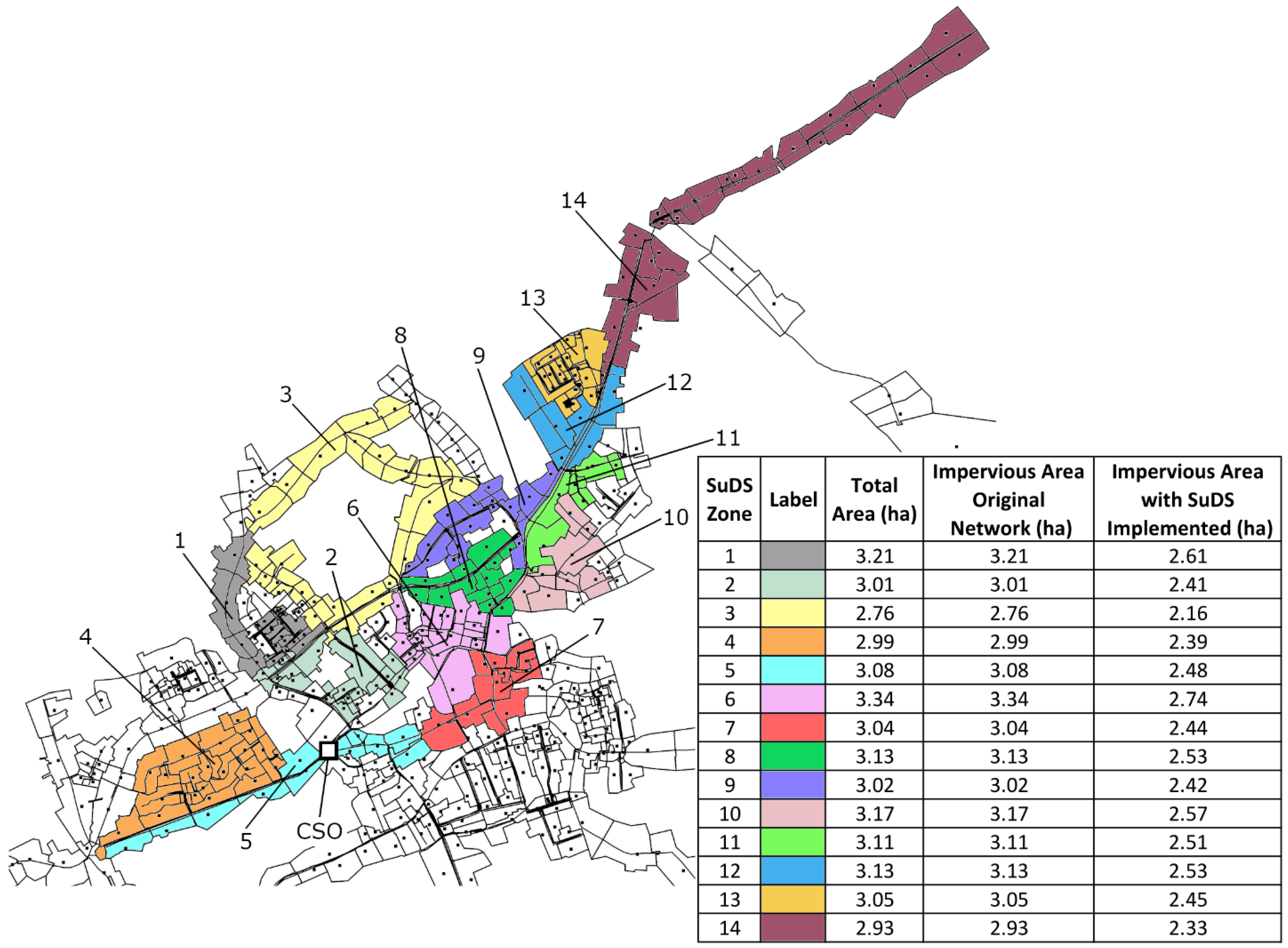
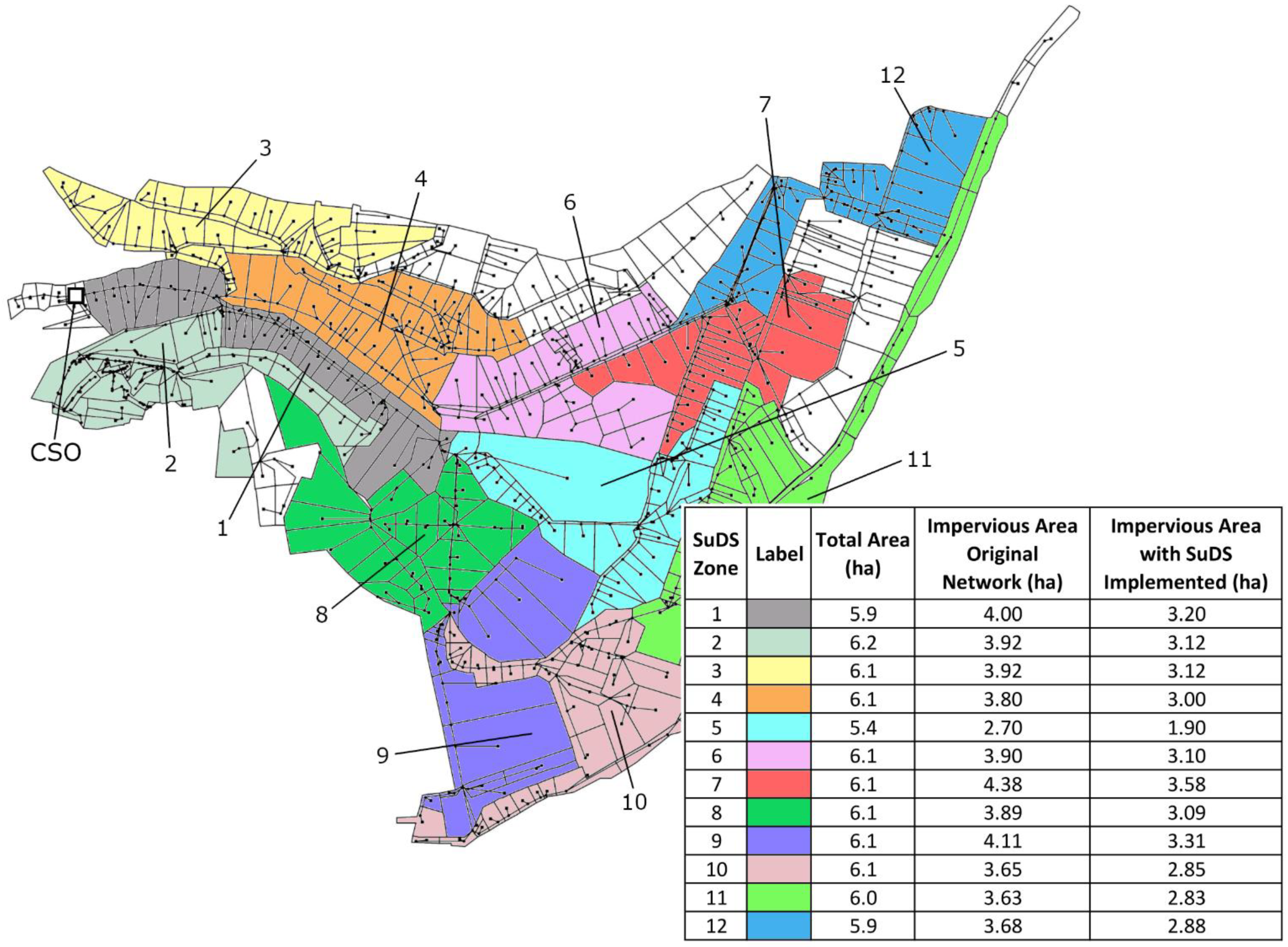

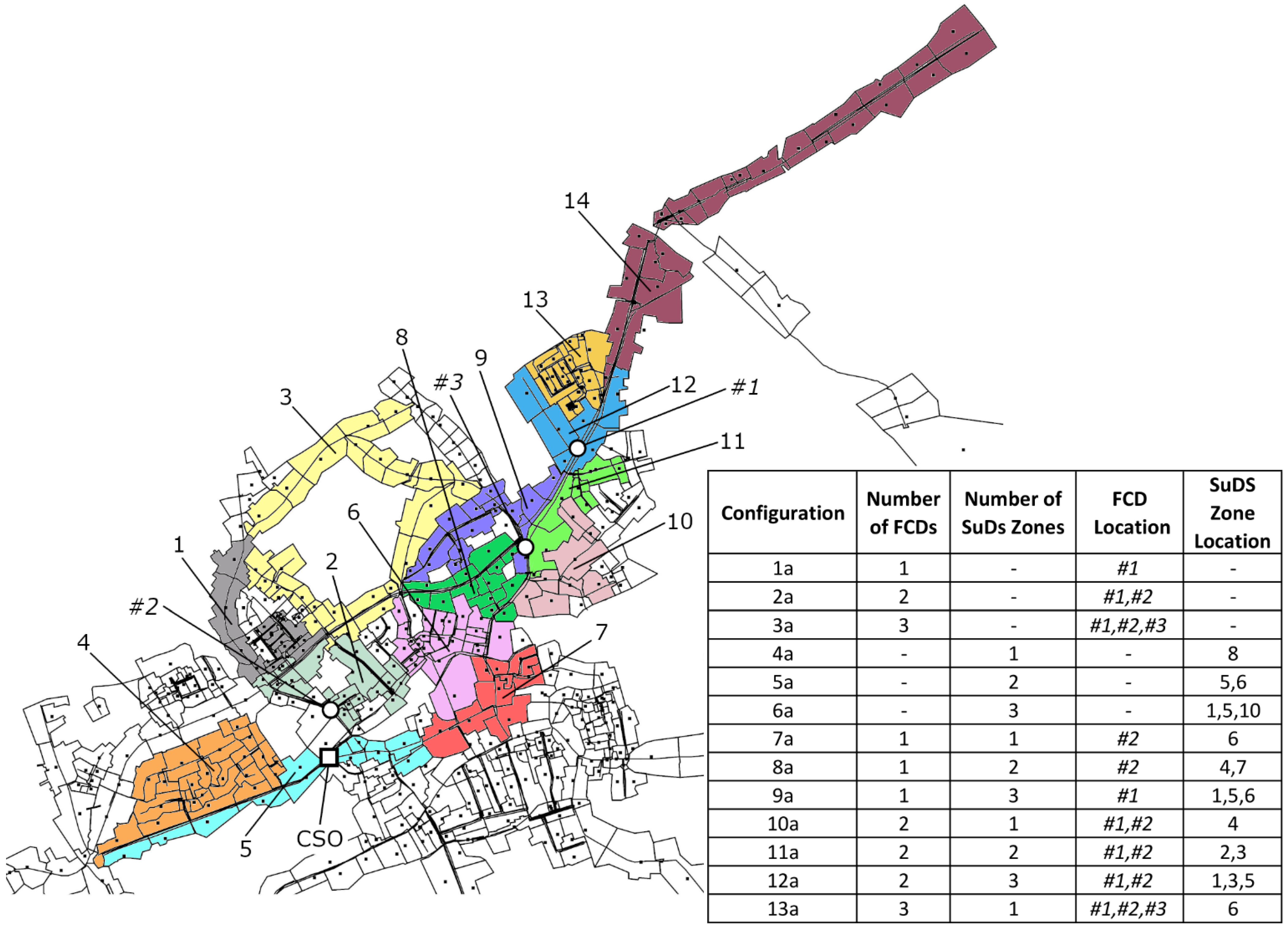
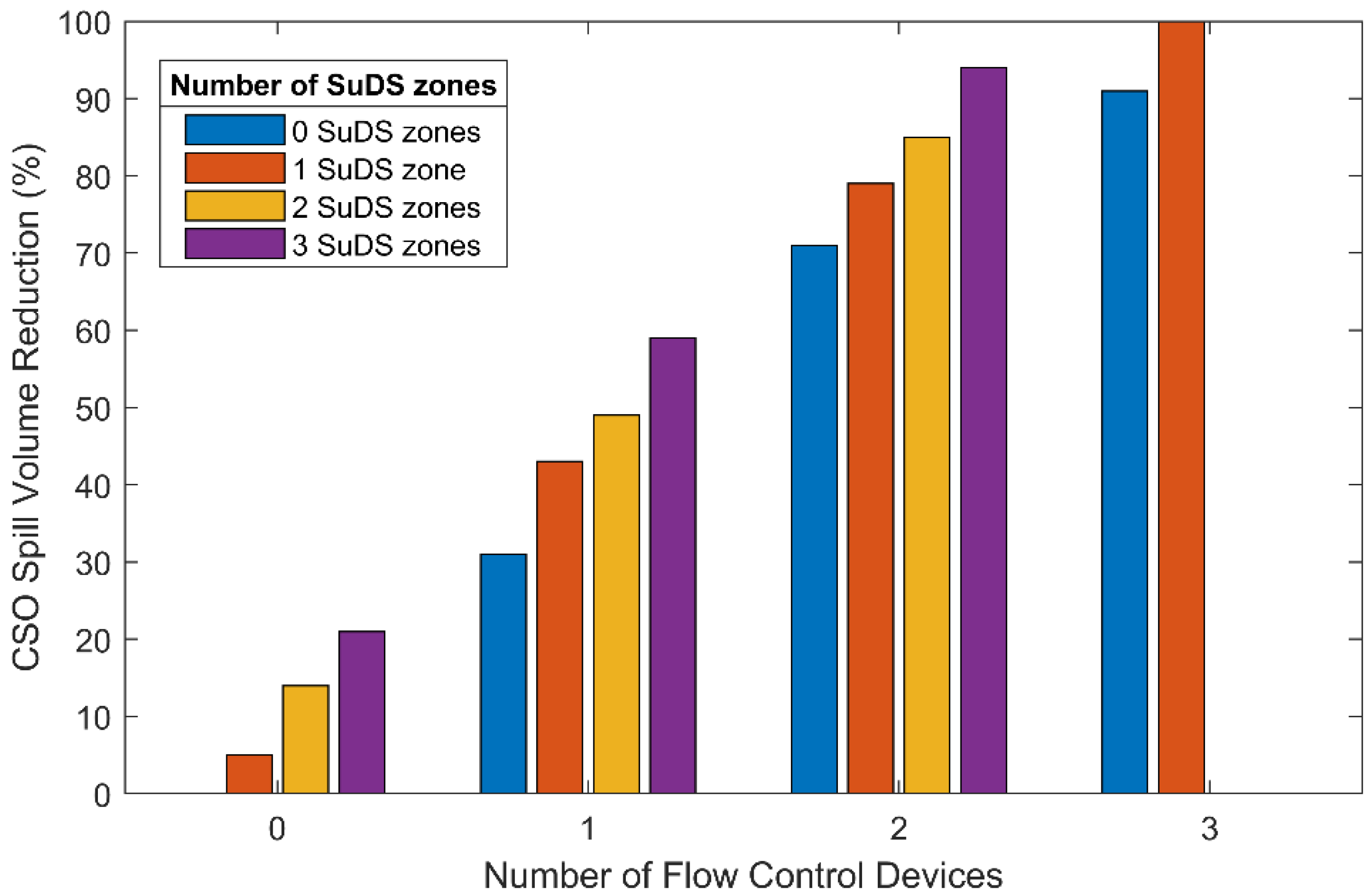
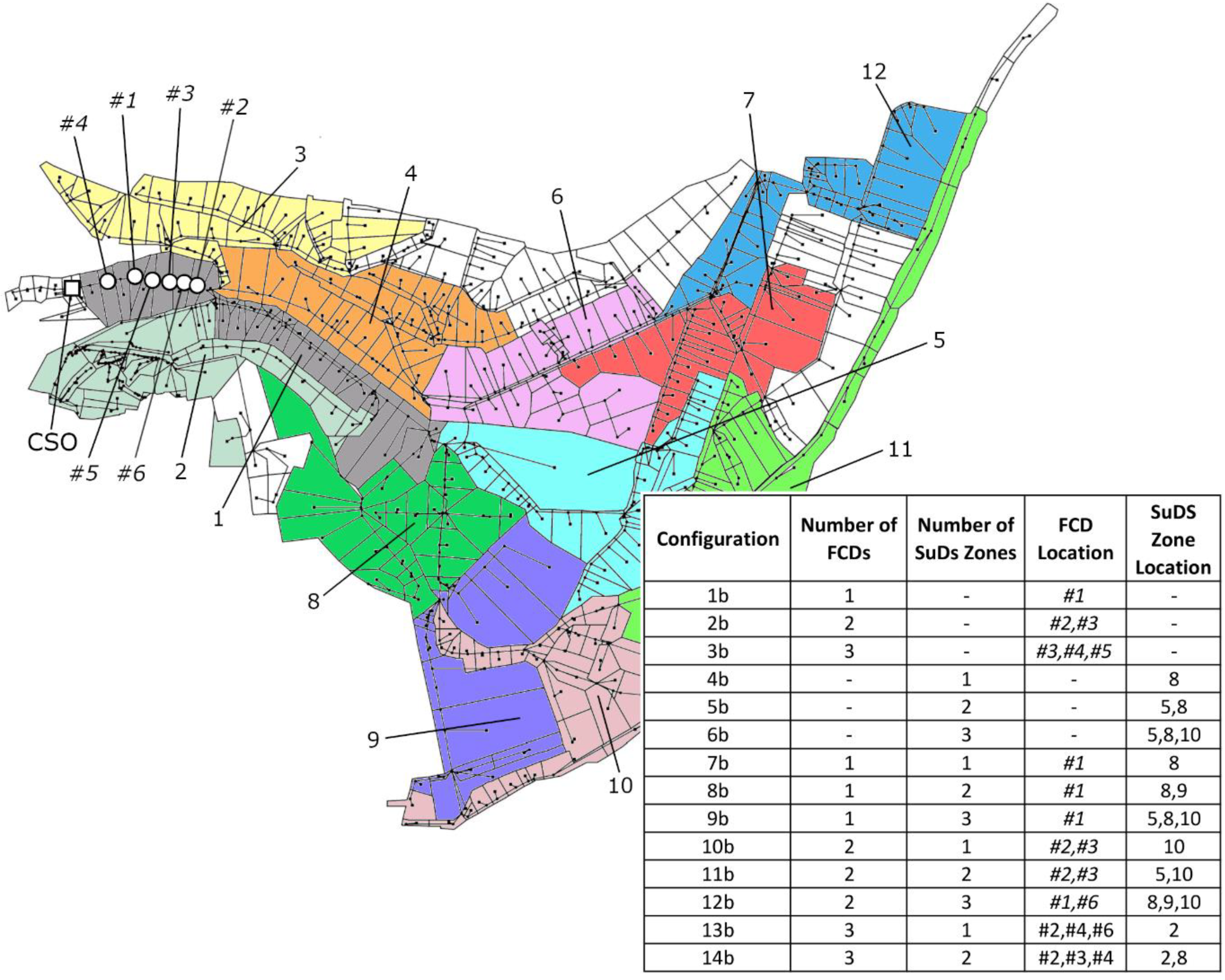
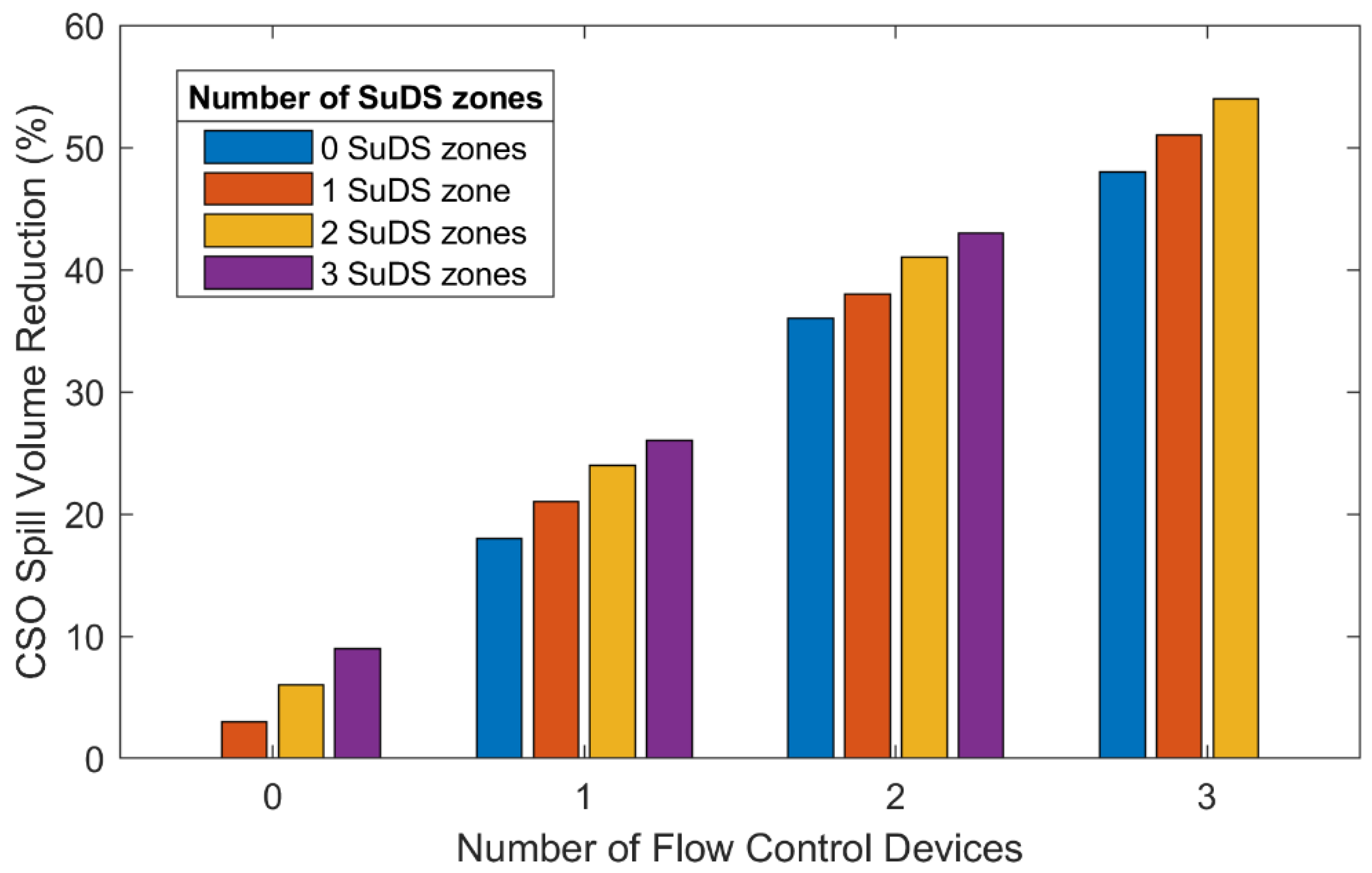
| Case Study | P.E. | Nodes | Links | Subcatchments | Contributing Area (ha) | Pipe Diameter (m) | Pipe Slope (m/m) | CSOs | ||
|---|---|---|---|---|---|---|---|---|---|---|
| Min | Max | Min | Max | |||||||
| Arendonk | 15,100 | 1572 | 1563 | 572 | 113 | 0.1 | 2 | −0.04 | 0.88 | 16 |
| Zona Central | - | 536 | 538 | 434 | 89 | 0.2 | 1.7 | −0.51 | 2.26 | 1 |
| Case Study | Number of FCD Locations in the Baseline Network | Number of FCD Locations Evaluated by the GA | Number of SuDS Zones Evaluated by the GA |
|---|---|---|---|
| Zona Central | 389 | 25 | 12 |
| Arendonk | 533 | 32 | 14 |
| FCD and SuDS Locations Obtained by GA in Benchmark with RTC + SuDS Scenario | FCD and SuDS Locations Obtained by GA in Benchmark with RTC and Benchmark with SuDS Scenarios, Respectively | |||
|---|---|---|---|---|
| No. of FCDs | No. of SuDS Zones | Configuration | CSO Spill Volume Reduction (%) | |
| 1 | 1 | 7a | 43 | 33 |
| 1 | 2 | 8a | 49 | 49 |
| 1 | 3 | 9a | 59 | 51 |
| 2 | 1 | 10a | 79 | 74 |
| 2 | 2 | 11a | 85 | 81 |
| 2 | 3 | 12a | 94 | 87 |
| 3 | 1 | 13a | 100 | 100 |
| FCD and SuDS Locations Obtained by GA in Benchmark with RTC + SuDS Scenario | FCD and SuDS Locations Obtained by GA in Benchmark with RTC and Benchmark with SuDS Scenarios, Respectively | |||
|---|---|---|---|---|
| No. of FCDs | No. of SuDS Zones | Configuration | CSO Spill Volume Reduction (%) | |
| 1 | 1 | 7b | 21 | 21 |
| 1 | 2 | 8b | 24 | 23 |
| 1 | 3 | 9b | 26 | 26 |
| 2 | 1 | 10b | 38 | 32 |
| 2 | 2 | 11b | 41 | 34 |
| 2 | 3 | 12b | 43 | 37 |
| 3 | 1 | 13b | 51 | 50 |
| 3 | 2 | 14b | 54 | 51 |
| Configuration | Number of FCDs | Number of SuDS Zones | Spill Volume Reduction Compared with Baseline Network (%) |
|---|---|---|---|
| 6a | - | 3 | 11 |
| 9a | 1 | 3 | 23 |
| 12a | 2 | 3 | 36 |
| 13a | 3 | 1 | 36 |
| Configuration | Number of FCDs | Number of SuDS Zones | Spill Volume Reduction Compared with Baseline Network (%) |
|---|---|---|---|
| 6b | - | 3 | 13 |
| 9b | 1 | 3 | 30 |
| 12b | 2 | 3 | 38 |
| 14b | 3 | 2 | 45 |
Publisher’s Note: MDPI stays neutral with regard to jurisdictional claims in published maps and institutional affiliations. |
© 2022 by the authors. Licensee MDPI, Basel, Switzerland. This article is an open access article distributed under the terms and conditions of the Creative Commons Attribution (CC BY) license (https://creativecommons.org/licenses/by/4.0/).
Share and Cite
Eulogi, M.; Ostojin, S.; Skipworth, P.; Kroll, S.; Shucksmith, J.D.; Schellart, A. Optimal Positioning of RTC Actuators and SuDS for Sewer Overflow Mitigation in Urban Drainage Systems. Water 2022, 14, 3839. https://doi.org/10.3390/w14233839
Eulogi M, Ostojin S, Skipworth P, Kroll S, Shucksmith JD, Schellart A. Optimal Positioning of RTC Actuators and SuDS for Sewer Overflow Mitigation in Urban Drainage Systems. Water. 2022; 14(23):3839. https://doi.org/10.3390/w14233839
Chicago/Turabian StyleEulogi, Marco, Sonja Ostojin, Pete Skipworth, Stefan Kroll, James D. Shucksmith, and Alma Schellart. 2022. "Optimal Positioning of RTC Actuators and SuDS for Sewer Overflow Mitigation in Urban Drainage Systems" Water 14, no. 23: 3839. https://doi.org/10.3390/w14233839
APA StyleEulogi, M., Ostojin, S., Skipworth, P., Kroll, S., Shucksmith, J. D., & Schellart, A. (2022). Optimal Positioning of RTC Actuators and SuDS for Sewer Overflow Mitigation in Urban Drainage Systems. Water, 14(23), 3839. https://doi.org/10.3390/w14233839







